HOOK
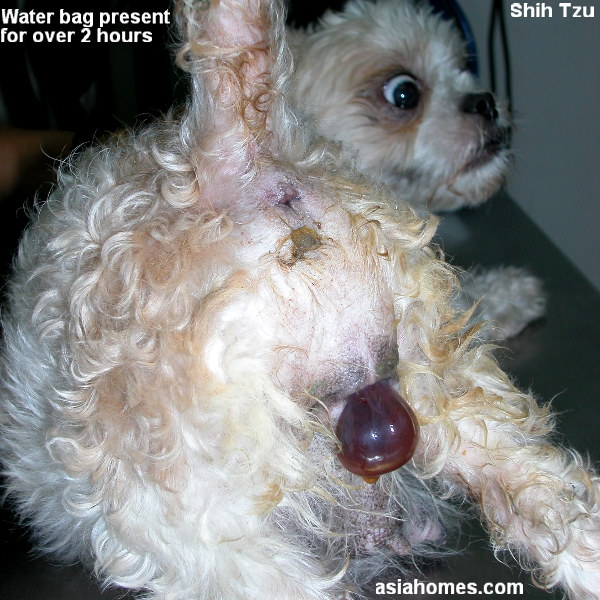
What shall the breeder do? His Shih Tzu has a water bag going in and coming out for the past 2 hours. Yet, no puppy was delivered naturally. Shall he wait longer? Shall he rupture the water bag himself and pull the puppy out? The puppy may be stuck tightly inside the pelvic canal and he will not be able to pull it out.
This is a BE KIND TO PETS Veterinary Educational Video sponsored by Toa Payoh Vets, Singapore.The objective is to bring Veterinary Medicine and Surgery Alive to pet owners and veterinary studuents.
This video shares practical tips and advices gained from performing over 200 cases of Caesarean sections at Toa Payoh Vets from 2003 to 2016.
INTRODUCTION
In 2003, most of the professional dog breeders in Singapore sent their dogs to Dr Sing Kong Yuen of Toa Payoh Vets for Caesarean sections. Their vet was suspended from practising.
From 2003 to 2006 and from 2015 and 2016, around 200 canine caesarean sections were performed.
Most of these cases are recorded in www.toapayohvets.com at:
http://www.bekindtopets.com/animals/20081201PAGE2_Dog_Surgery_Anaesthesia_ToaPayohVets.htm
MIDDLE
In the Shih Tzu mentioned above, Dr Sing did an emergency caesarean section and a healthy pup was delivered alive.
This video discusses the process involved in managing the 2 types of caesarean sections, also called C-sections in dogs. These are the Elective and the Emergency C-sections.
PART 1. - ELECTIVE C-SECTION
Much planning must be done to ensure a good outcome for the dam and her puppies. The following are the guidelines:
1. 59 - 60 from the first breeding date usually results in mature, vigorous, active puppies in small breeds like the Chihuahua and Yorkshire Terriers in Singapore.
2. Serum Luteinizing Hormone (LH) assay is a very excellent laboratory test to schedule an elective Caesarean section. I have heard of this method being done by an English Bulldog breeder in Thailand as this breed sells at a very good price when exported to Britain. The progesterone concentration is approximately 2 ng/ml at the initial stage of ovulation. This level indicates an LH surge. Most bitches will whelp 65 days after the LH surge. The first breeding is advised at Day 3 and Day 5 after the progesterone level reaches 2 ng/ml.
3. If the serum LH assay is not available, an ultrasound scan at Day 23 after the first breeding may be done. The gestational vesicle is usually round at Day 23 and oval at Day 25. Foetal death/resorption and early pyometra may be detected during the ultrasound scan.
4. Resting rectal temperatures from Day 55 after the first breeding to be done by the breeder.
Rectal temperatures drop to 99 degrees F (37.2 degrees C), 8 -12 hours before the onset of labour. A breeder can be advised to monitor the resting rectal temperature from Day 55. For practical purposes, I advise Day 58.
PART 2 - EMERGENCY C-SECTION.
The guidelines are as follows:
Dystocia (difficulty in giving birth) is the reason for seeking Emergency C-sections. Some cases are shown
(Clara to read the text/image) rather than flashing them by.
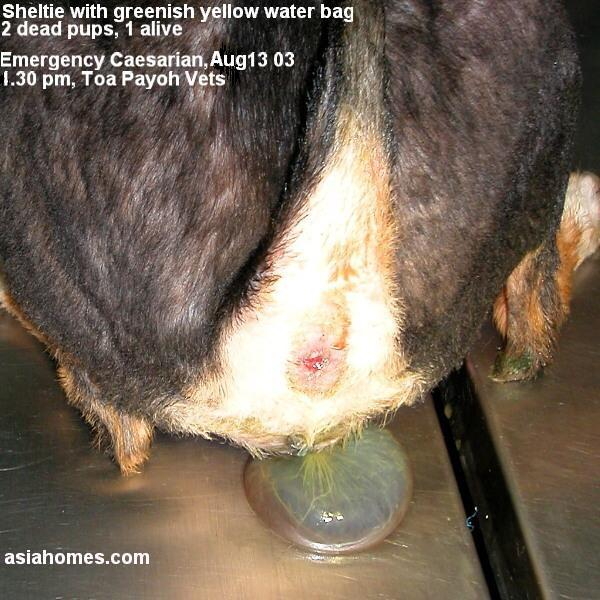
PROCESS AT TOA PAYOH VETS
1. The bitch is weighed. Rectal temperature is taken. A physical examination is done.
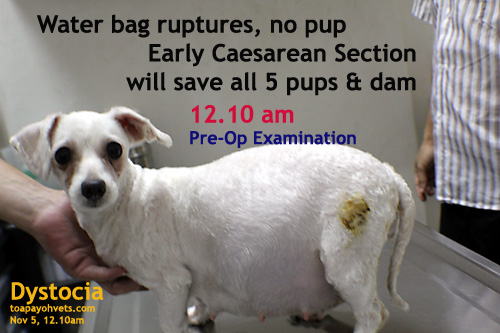
2. Blood for a serum chemistry panel and ultrasound scan are advised.
3. Anaesthesia & Surgery Record book. Performance of a vet is monitored. Time when the dog is given gas via the gas mask to time at completion of stitching.
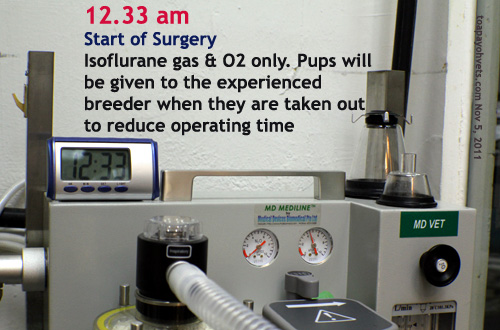
4. Pre-anaesthetic medication. Glycopyrrolate + butorphanol is not done for all the bitches of the small breeds as I find that there is rarely any excitement phase during induction by isoflurane gas in the mask in the small breeds.
4.1 Some Singapore vets induce with propofol IV, intubate and then maintain with isoflurane + oxygen. Since 2003, over 200 Caesarean sections, mostly small breeds for the dog breeders have no pre-anaesthetic medication. Butorphanol may be given after Caesarean section so as not to cause drowsiness in the pups.
5. The bitch may be given oxygen therapy by mask for at least 5 minutes before induction if she is distressed.
6. An IV Hartmann's Solution is given. 5% glucose IV for 5 minutes will be given if the bitch is in distress.
GAS ANAESTHESIA. The dam is given isoflurane and oxygen gas via a gas mask..
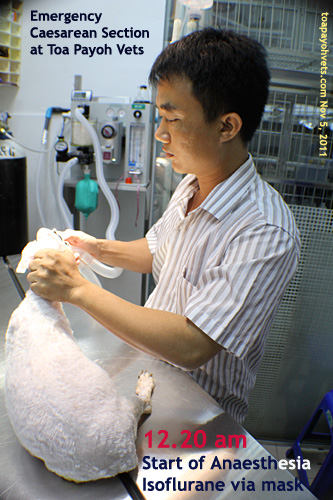
When the dam is sleepy, an endotracheal tube is inserted to continue giving the gas to the dog.
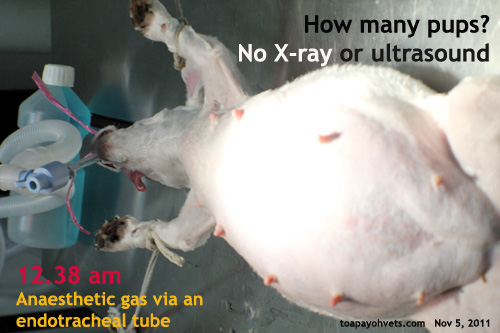
Nearly 100% of the small breed cases do not show excitement during induction by gas mask and therefore pre-medication anaesthetic is not given. For fractious dogs, a container instead of a mask can be used. Healthy puppies are vigorous and cry within 2 minutes after delivery.
SURGERY
1. There are 3 surgical approaches for C-sections. Each vet has his or her own way. These are:
1.1 Exteriorise the whole uterus. A longer skin and abdominal incision is needed.
1.2 Two uterine horn incisions. This is said to be speedier in removing pups.
1.3 Uterine body incision. Some vets are worried that the cervix may be incised.
Dr Sing Kong Yuen practised the uterine body incision for his over 200 Caesarean sections. The skin wound is also much shorter and the stitches are less likely to break down. (Clara to narrate the text in the image)
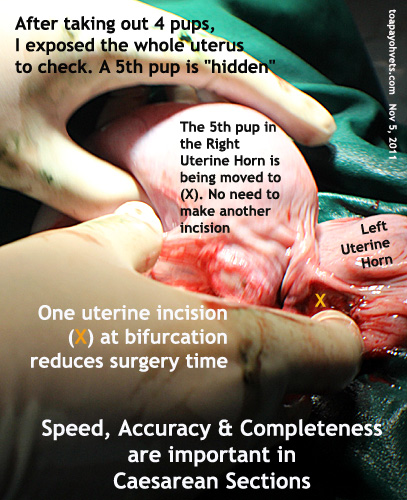
ILLUSTRATION OF SURGERY (Clara to read the text in the illustrations)
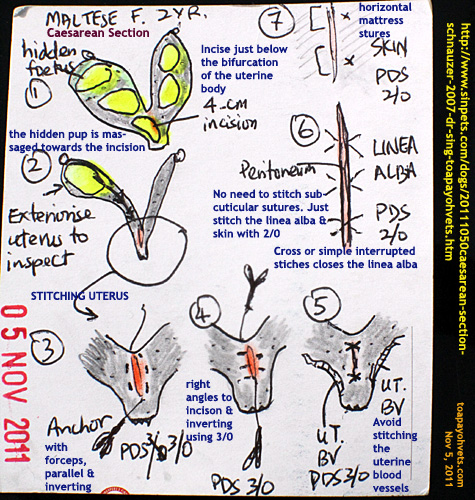
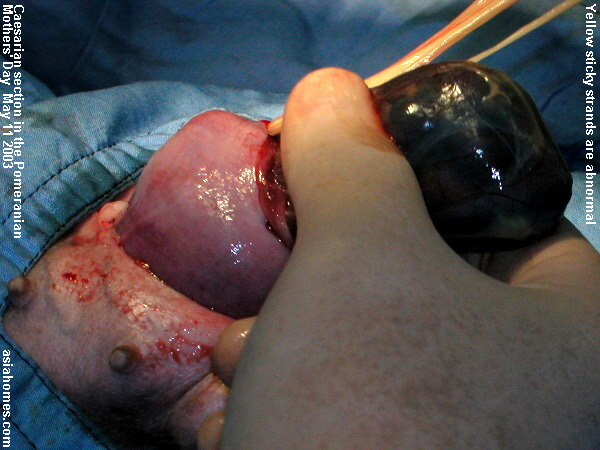
2. The pup is removed from the uterus and the chorionic and amniotic sacs are opened. The umbilical cord is clamped 1 cm away from the puppy's abdomen. Another forceps clamp lower down. The umbilicus is cut. I do not find any difficulty in removing the placentas from the uterus, using gentle manipulation to loosen the attachments.
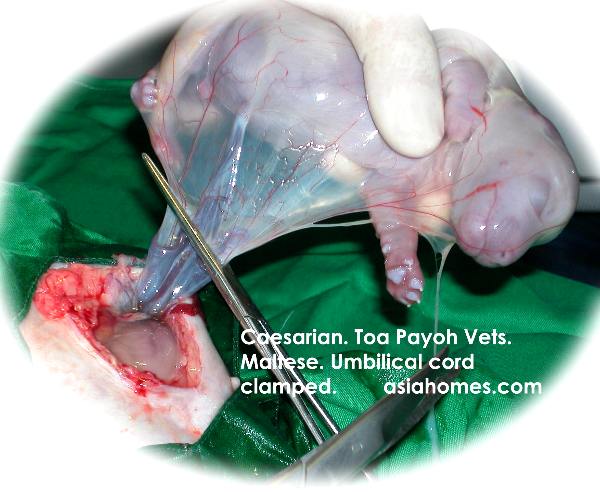
2.1 It is very important to exteriorise the empty uterine horns including the ovaries. This will ensure that there is no hidden pup near the ovaries. Dr Sing also palpate the pelvic area to check for pups stuck near the cervix.
If this inspection procedure is not done, some breeders may return with a pup born naturally after Caesarean section!
3. The assistant or breeder takes over the pup. The pup's mouth and nostril are cleared with a gauze swab. The pup is rubbed on the neck with his head down to stimulate breathing and to clear the lungs of fluid. Neck skin pinching may be used to stimulate breathing.
4. Swinging the distressed pup does not cause intracranial bleeding in Dr Sing'sexperience. There are vets and breeders who believes differently. Dr Sing grips the pup's head with both hands, stand with my legs apart and swing the pup from above my head downwards. A firm grip is necessary to prevent the pup slipping through the hand and dropping onto the floor.
ILLUSTRATION
Clara
google "swinging puppies toa payoh vets" and show the video clip (relevant section).
5. Stitching the uterus. Two rows of inverting continuous sutures. I use absorbable 2/0 or 3/0 sutures for all closing of the uterus, muscle, fascia and skin in simple interrupted sutures. Buried subcuticular layers may break down and cause irritation under the skin and so I have not used them.
6. Oxytocin and antibiotic injections are given SC. Some vets give buprenorphine (0.075mg/10lb) IM.
7. A bloody vaginal discharge after Caesarean section is normal and does not last more than 3 days.
8. Ensure that the puppies are introduced to the dam and suckle before they go home. The owner is advised to supervise the dam closely for the next 24 hours as some do kill the puppies.
9. If the puppies do not eat after 24 hours or gain weight, tube feeding with supplemental milk is advised.
10. A calcium injection SC is given for small-breed dams producing more than 3 puppies. Some distressed dams are sent home with another bottle of IV Hartmann's solution. Some dams do not eat for the past 2 days before the estimated due date of 58th day for Chihuahua. An IV calcium drip may save the pups are in this case.
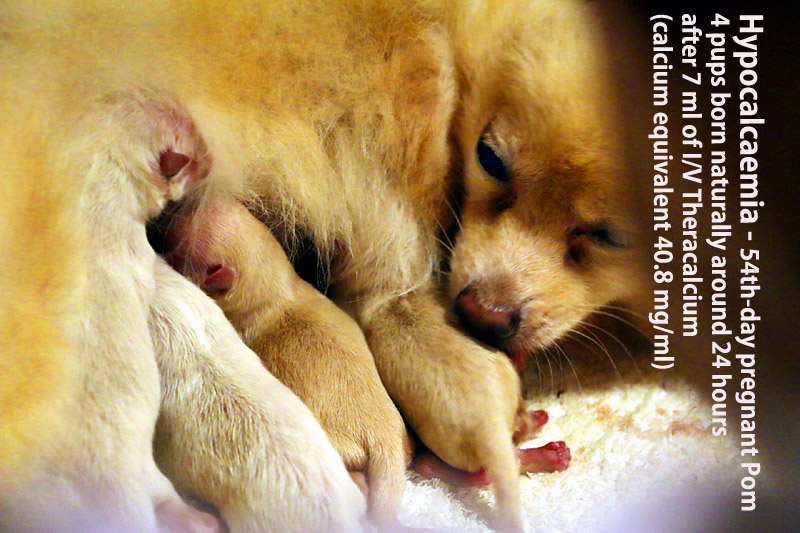
CONCLUSION
Dr Sing's best advices to dog breeders who do not want to incur high medical costs are as follows:
1. The water bag appears at the vagina but there is no puppy delivered naturally. If the first puppy is not born within an hour of these strong contractions, take the bitch to the veterinary surgeon for an emergency Caesarean section. By the time the surgery is done, 2 hours will have passed.
2. Seek an emergency C-section if labour does NOT resume within 2 hours after the birth of the previous puppy or the bitch is restless, feverish, ignores her puppy or has a bloody and/or foul-smelling vaginal discharge.
Clara to narrate the main points of the text of all slides, not just showing them
3. In small breeds like the Chihuahua and Yorkshire Terriers,less than 2 hours after the birth of the previous puppy is best practice. Chances of puppy survival are slim if delay is more than 3 hours. There will be distressed puppies and puppies not suckling after the surgery.
4. Breeds like the Chihuahua (small pelvis), Pekingese, Bulldog (big head), Boston Terrier, Toy Poodle may require Caesarean deliveries if you wish to have healthy live puppies.
REFERENCES
www.toapayohvets.com
http://www.bekindtopets.com/animals/20081201Dog_Surgery_Anaesthesia_ToaPayohVets.htm
http://www.bekindtopets.com/animals/20081201PAGE2_Dog_Surgery_Anaesthesia_ToaPayohVets.htm
EXAMPLES OF CASES DONE BY DR SING KONG YUEN
Clara to narrate the text's main message
Infections do occur in mid-pregnancy. Blood tests show kidney failure in this dam.
Chihuahua not giving birth after 2 hours of labour pains. An emergency C-section saves some pups if performed less than 2 hours after labour pains.
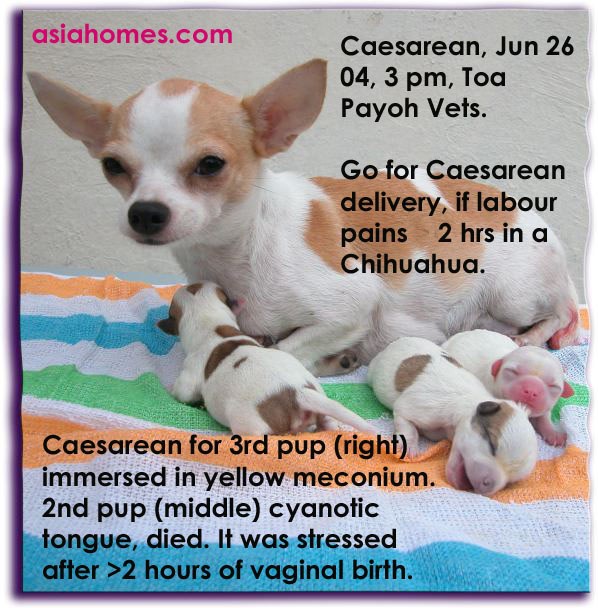
A black greenish vaginal discharge indicates puppy death and placental necrosis.
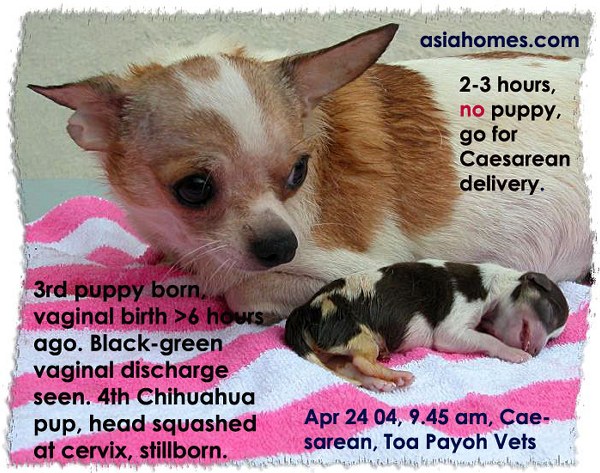
8 hours' delay in seeking C-section results in a dead pup.
A large pup obstructs other smaller pups from being born.
SINGLE PUP SYNDROME refers to only one pup conceived. The pups grows bigger every day but there are no signs of labour pains.
Occasionally, a single pup over 70th day may be born naturally. But most will die as they have grown too big in size to be born via the vagina.
70TH DAY. PUP ALIVE. One breeder claims that 73rd day, single pup can be born naturally. But this is the exception rather than the rule.
EXTRA-LARGE PUPS NEED C-SECTION TO SURVIVE
LARGE PUPS JAMMED INSIDE UTERUS
lst PUP BORN BY VAGINA. NO 2ND PUP. HOW LONG TO WAIT?
MUMMIFIED FOETUS AND STILLBORNS. Ultrasound.
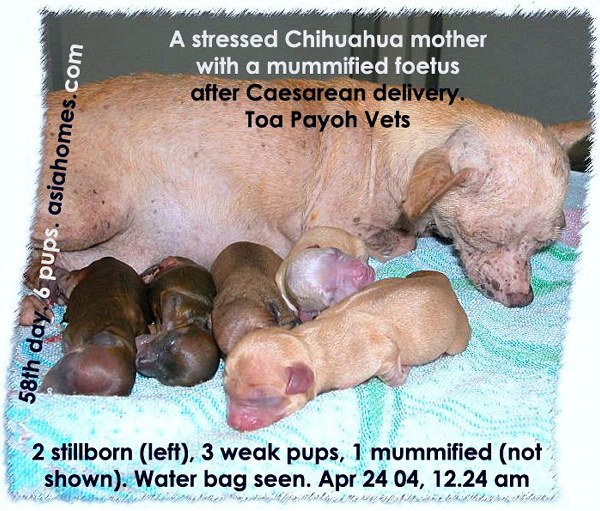
Much depends on the breeder's judgment on when to go for the C-section. The earlier it is done, the higher the chances of puppy survival.
A
Yorkshire Terriers usually require elective C-sections although some may be born naturally. As most Singapore dog breeders do not wish to incur medical costs on regular ultrasound scans and check ups, an elective C-section will be advised for small breeds with many puppies.
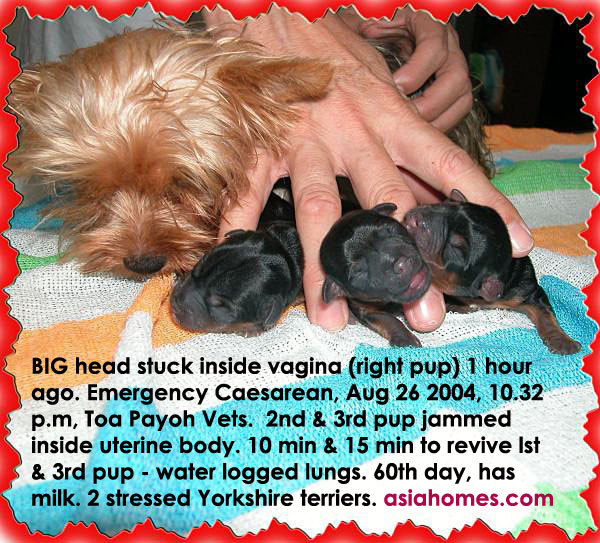
The above are a selection of Dr Sing's interesting C-section cases. Many home breeders have no time to research on the reproduction of the dog as they lead hectic lives.
They may find the following information useful
REPRODUCTION IN THE DOG
1. By 4 months of age, male dogs may mount the owner or show interest in the sexually receptive female. However, males usually can't successfully breed till they are over 9 months old.
2. Female dogs experience their first bleeding at about 6 months of age (the first breeding cycle). The cycle is usually twice a year but may be more than two or less. The Basenji cycle once a year.
3. Large breeds of both sexes may take 18 - 24 months to become sexually mature.
4. A healthy bitch will have "heat" all her life but reproductive problems occur generally after 8 years of age. Some vets advise no breeding after 5 years of age as puppy quality is poor.
5. The CANINE "HEAT" has 4 stages.
5.1 PROESTRUS. Around 9 days. Swelling of vulva and a dark, bloody red vaginal discharge.
5.2 ESTRUS. Around 7-9 days. When the progesterone concentration is approximately 2 ng/ml, this indicates the initial stage of ovulation. This stage is known as the Luteinizing Hormone (LH) surge. Most bitches whelp at 65 days after the LH surge. Vaginal discharge is now a faint pink colour and the bitch is sexually receptive. Some vet reports advise first breeding to be at the 3rd and 6th day of estrus.
5.3 DIESTRUS. Around 2 months.
5.4 ANESTRUS. Around 4.5 months.
6. GESTATION (Conception to birth period of time). Average is 63 - 65 days. Puppies may also be born between day 56 - 72. Some reports mention gestation as 59 - 63 days after first mating. In the SINGLE PUP SYNDROME, the pup may be born naturally at the 72nd day but a Caesarean section is advised for small breeds like the Chihuahua as there will be dystocia and foetal distress.
7. PREGNANCY DIAGNOSIS BY THE VET. Day 23 - 27 after the first breeding is preferred for abdominal palpation of spherical gestational vesicles. Some vets advise ultrasound at Day 23 when spherical gestational vesicles can be seen and at Day 25 when these vesicles become oval. Foetal death/resorption and early pyometra may be seen during ultrasound scan at Day 23 and 25.
8. ABDOMINAL SWELLING is usually seen at Day 35 or 42. Large dogs that carry puppies high beneath their rib cage may not look pregnant.
9. NIPPLE SWELLING and colour from darken to rosy pink at Day 40.
10. RESTING RECTAL TEMPERATURES drop to 99 degrees F (37.2 degrees C), 8 -12 hours before the onset of labour. A breeder can be advised to monitor the resting rectal temperature from Day 55.
11. lst STAGE of labour lasts 6 - 24 hours. Restless, pant, shiver, vomit, pace, scratch floor, vomit.
12. 2nd STAGE of labour - birth of puppy.
13. 3rd STAGE of labour - explusion of the placenta. Usually passed out 5-15 minutes of each puppy birth.
14. If there is more than 1 puppy, 2nd and 3rd stages alternate.
15. VAGINAL DISCHARGE shows imminent birth. Then involuntary muscle contractions. The water bag may appear at the vagina but there is no puppy delivered naturally. If the first puppy is not born within an hour of these strong contractions, take the bitch to the veterinary surgeon for an emergency Caesarean section.
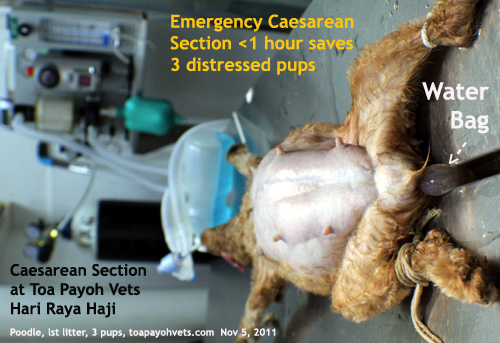 16. See your vet for an emergency Caesarean section if labour does NOT resume within 4 hours
after the birth of the puppy or the bitch is restless, feverish,
ignores
her puppy or has a foul-smelling vaginal discharge. In small
breeds like the Chihuahua and Yorkshire Terriers, I will advise less than 2 hours
after the birth of the puppy as chances of survival are slim if further
delay leads to distressed puppies and puppies not suckling after the
surgery.
16. See your vet for an emergency Caesarean section if labour does NOT resume within 4 hours
after the birth of the puppy or the bitch is restless, feverish,
ignores
her puppy or has a foul-smelling vaginal discharge. In small
breeds like the Chihuahua and Yorkshire Terriers, I will advise less than 2 hours
after the birth of the puppy as chances of survival are slim if further
delay leads to distressed puppies and puppies not suckling after the
surgery. CREDITS
Dr Sing Kong Yuen, BVMS (Glasgow), MRCVS
Toa Payoh Vets, Singapore
www.toapayohvets.com
Queens Veterinary Surgery, Singapore
queensvets.com
Consultant, Royal Asia Veterinary Surgery, Yangon, Myanmar
www.royalasiaveterinarysurgery.com

Written by Dr Sing Kong Yuen:
June 5, 2016
Hotel Madira, Myitkyina, Myanmar
Dr Daniel Sing etc
Clara etc.
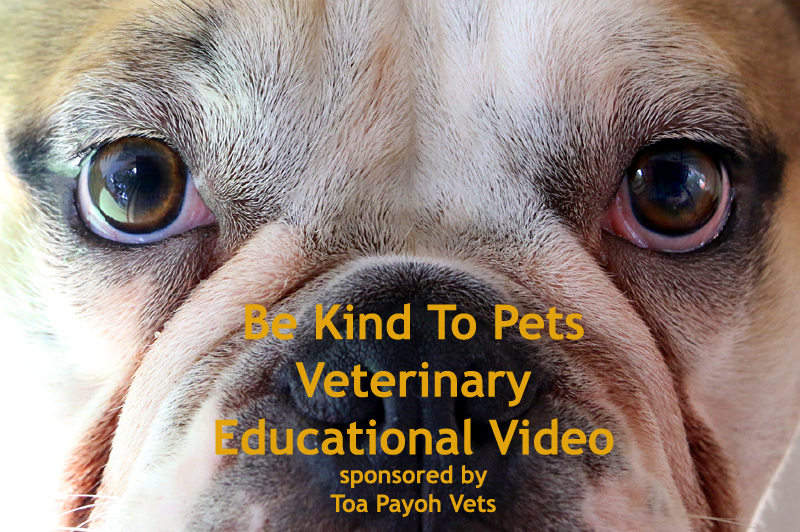
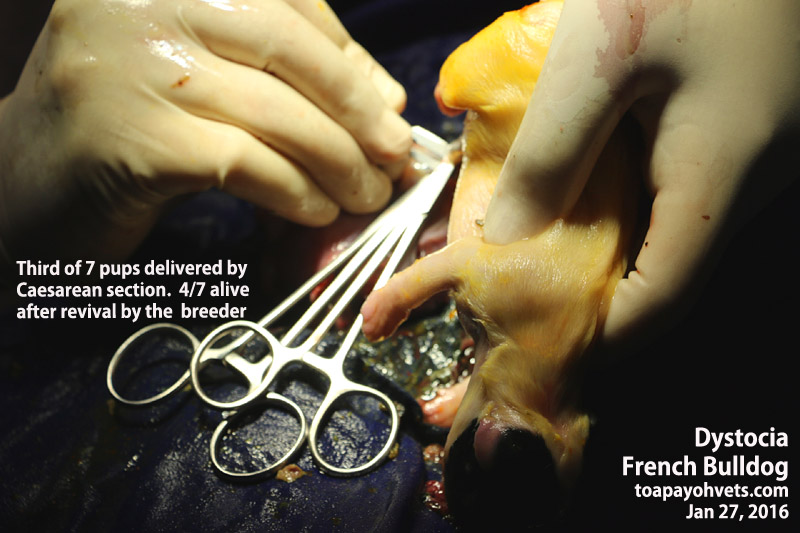
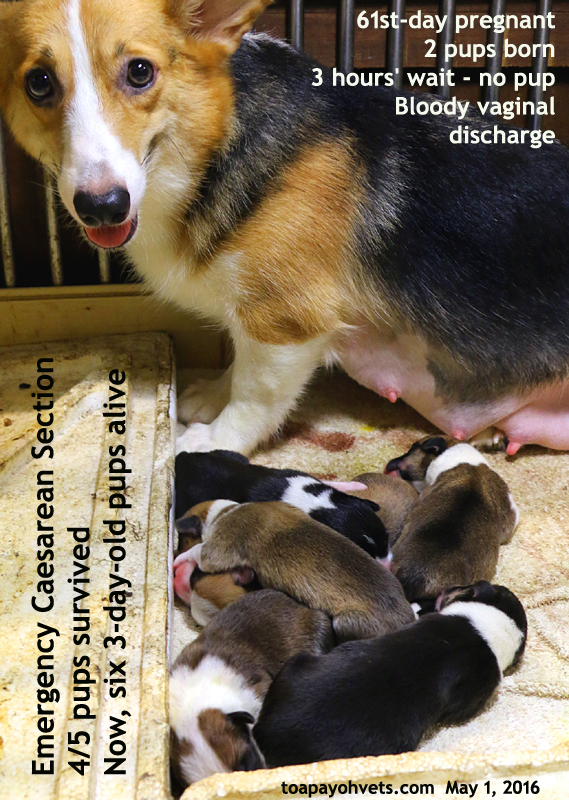
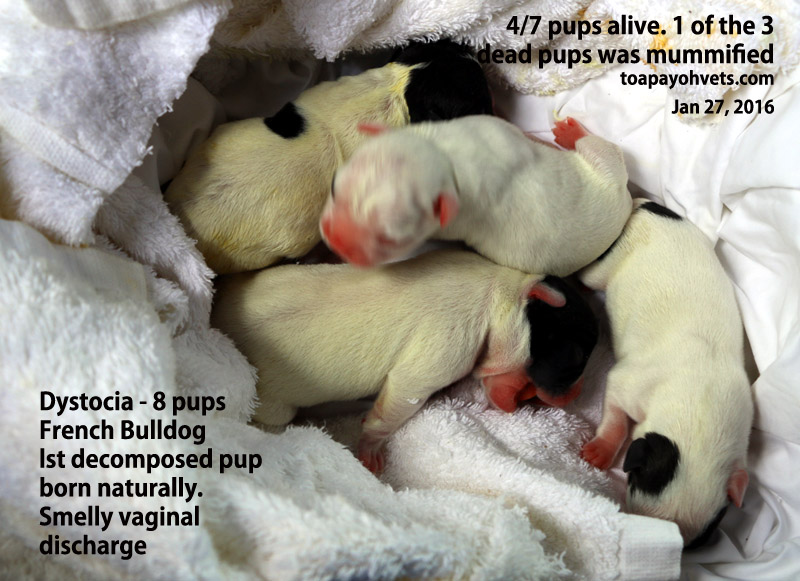
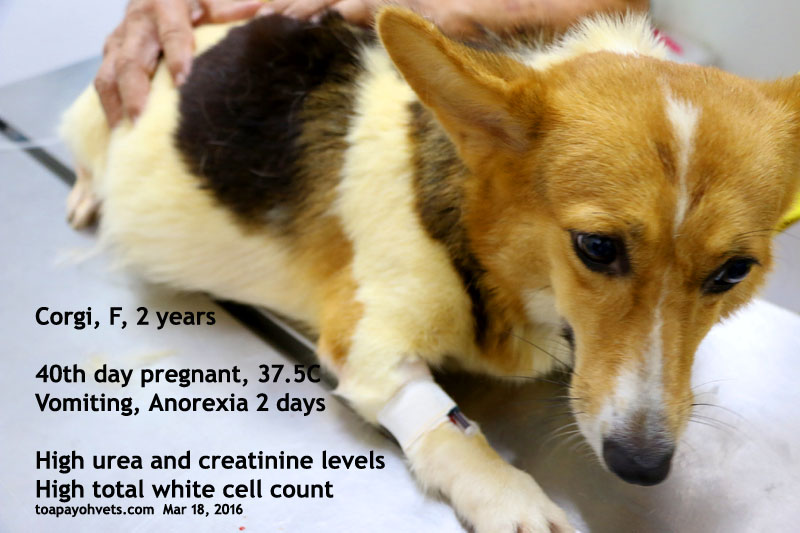
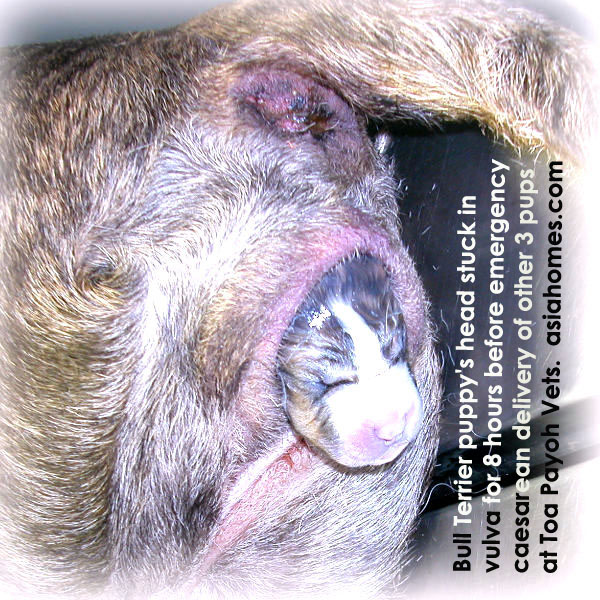
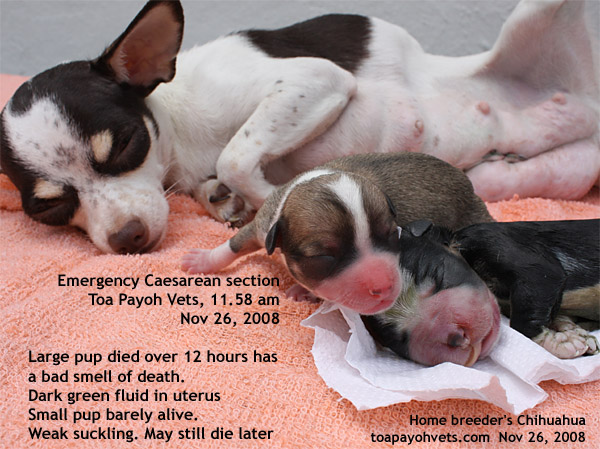
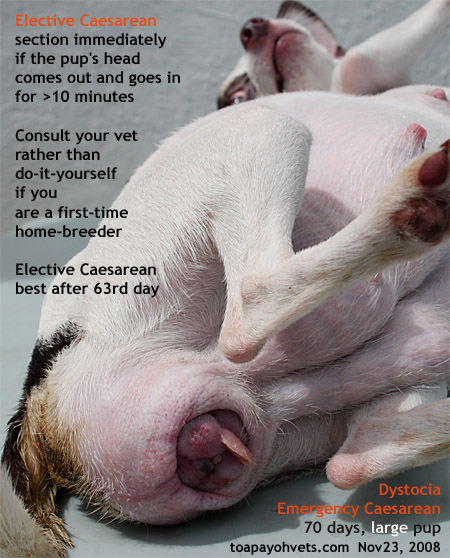
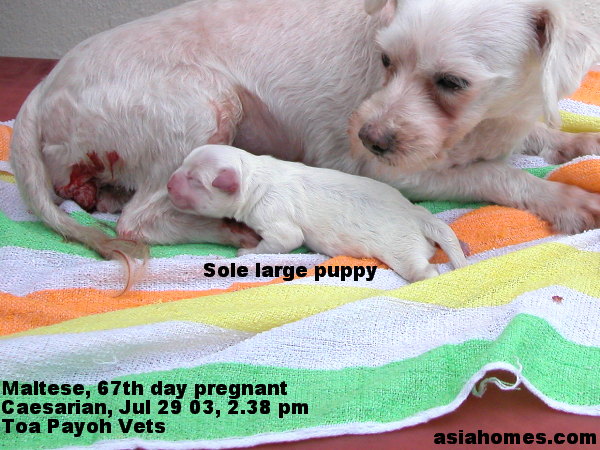


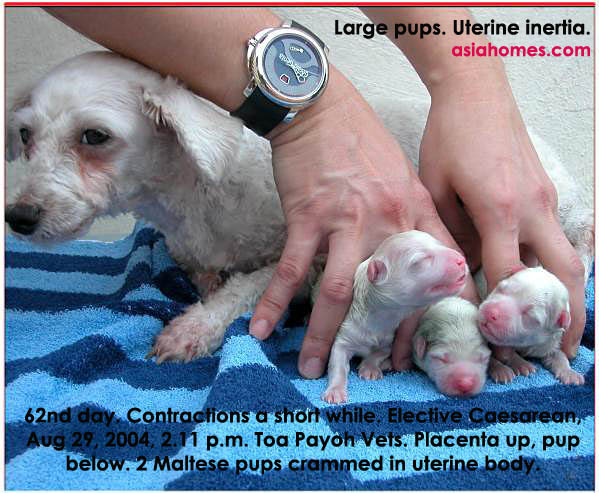
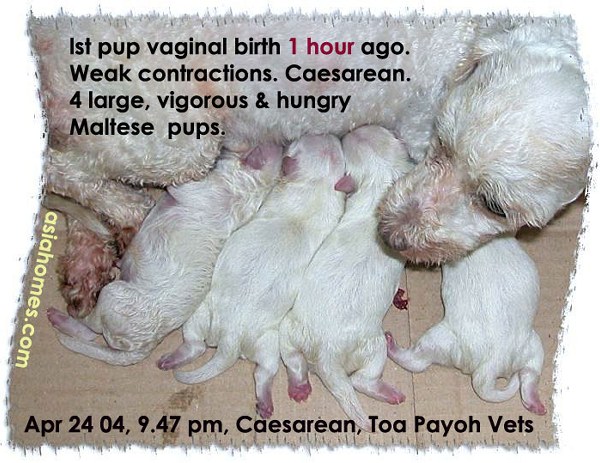
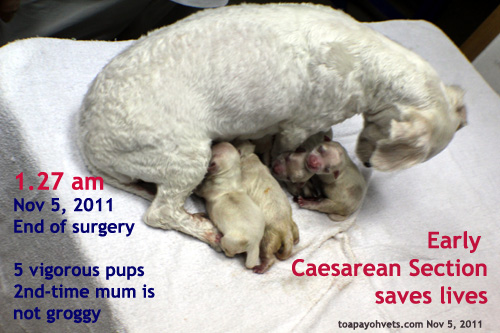
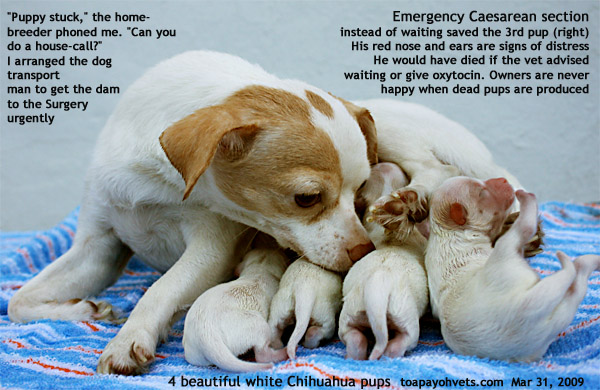
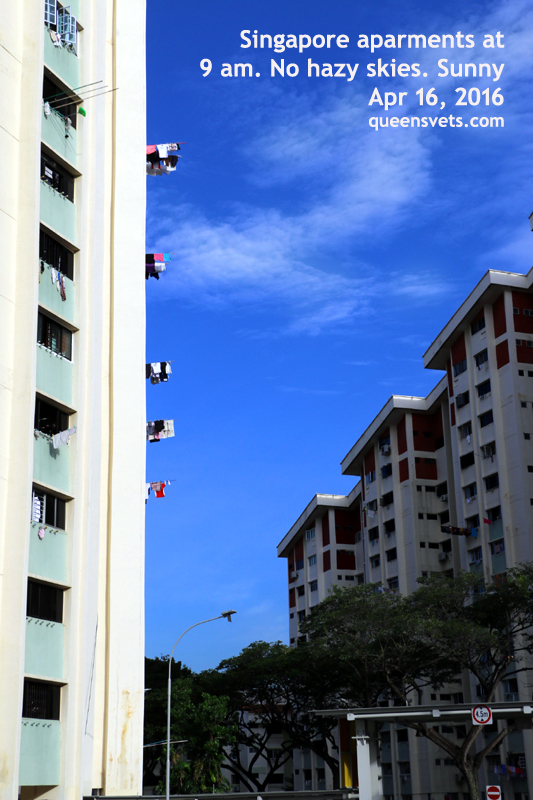

No comments:
Post a Comment